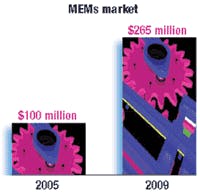MUNICH, Germany - The market for microelectromechanical systems (MEMS) in aerospace, defense, and homeland security will more than double from $100 million in 2005 to $265 million in 2009, predict analysts at Wicht Technologie Consulting (WTC) in Munich, Germany.
Potential opportunities for microelectromechanical systems (MEMS) technology to defense technologies such as aerodynamics, mobility, stealth, sensing, power generation and management, and smart structures and materials, WTC experts point out.
To date, the most established application of MEMS in defense is in inertial measurement units for weapons, guidance, navigation, and stabilization. In 2005, inertial sensors for weapon guidance-predominantly accelerometers and gyroscopes-accounted for half of the MEMS defense market.
Infrared sensors such as microbolometers for field and camp monitoring and firefighters also are already established on the defense market. MEMS pressure sensors also are commonly found in flight-control systems or in the monitoring of aircraft cabin pressure and hydraulic systems.
By 2009, inertial sensors will maintain their 50 percent share of the market and will be used in new applications such as inertial measurement units for soldiers on the battlefield. The major change will concern RF MEMS, which will enter serial production and account for a quarter of the MEMS defense market, mainly for use within phased-array antennas.
With the exception of smart munitions, which generate millions of units, the aerospace, defense, and homeland-security markets are generally characterized by low volumes relative to the civil sector. As a result, defense-specific developments are avoided if possible and so-called dual-use developments are favored instead-a development that benefits defense and aerospace applications as well as the mass-market civil applications, WTC analysts say.
An example of this trend includes projects such as a DARPA-funded project with HP for developing MEMS-based data storage devices that can also find their way into volume commercial markets. Another example relates to BAE Systems’ leverage of its MEMS gyro development for the military market into the automotive industry, achieved through a joint venture with Sumitomo Precision Instruments to establish Silicon Sensing Systems.
However, the specifics of the defense market are limiting for dual-use developments, WTC experts say. In the context of military systems, the performance of such devices must satisfy the stringent specifications and environmental conditions in such applications. In general, operational and environmental requirements will include resilience to radiation, high temperatures (including sharp cycles in excess of 150°C), vibration and shock (up to 100,000 G levels of force), as well as electromagnetic compatibility.
For more information contact WTC online at www.wtc-consult.de.



